Finance in Hospitality: Funding, Cost Control & Performance Analysis
VerifiedAdded on 2024/05/17
|20
|5581
|206
Report
AI Summary
This report provides a comprehensive analysis of finance within the hospitality industry, focusing on funding sources, cost control, and financial performance. It identifies various funding methods, including short-term, medium-term, and long-term options, and evaluates their contribution to income generation, using Belgravia Hotels as a case study. The report discusses elements of cost and profit, emphasizing the role of setting selling prices in the service business environment. It evaluates methods for controlling stock and cash, highlighting the costs and benefits of different approaches. Furthermore, the report explains trial balances, assesses business accounts, and analyzes budgetary control processes, offering recommendations for future actions. Through the calculation and analysis of financial ratios, the report interprets business performance and suggests management strategies for improvement. Finally, it categorizes costs as variable, fixed, and semi-variable, calculates per customer contributions, and justifies the use of break-even analysis for short-term decision-making.
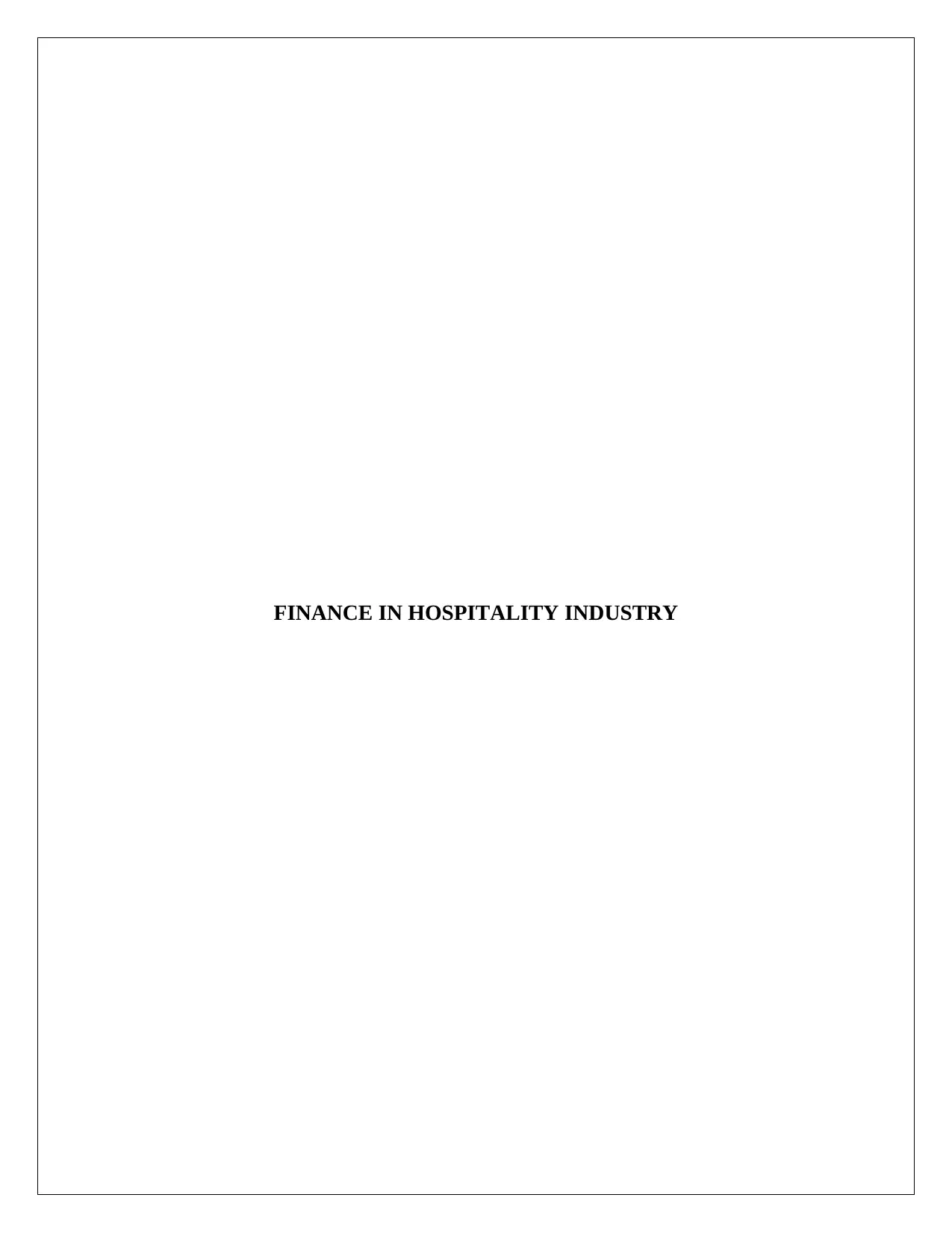
FINANCE IN HOSPITALITY INDUSTRY
Paraphrase This Document
Need a fresh take? Get an instant paraphrase of this document with our AI Paraphraser
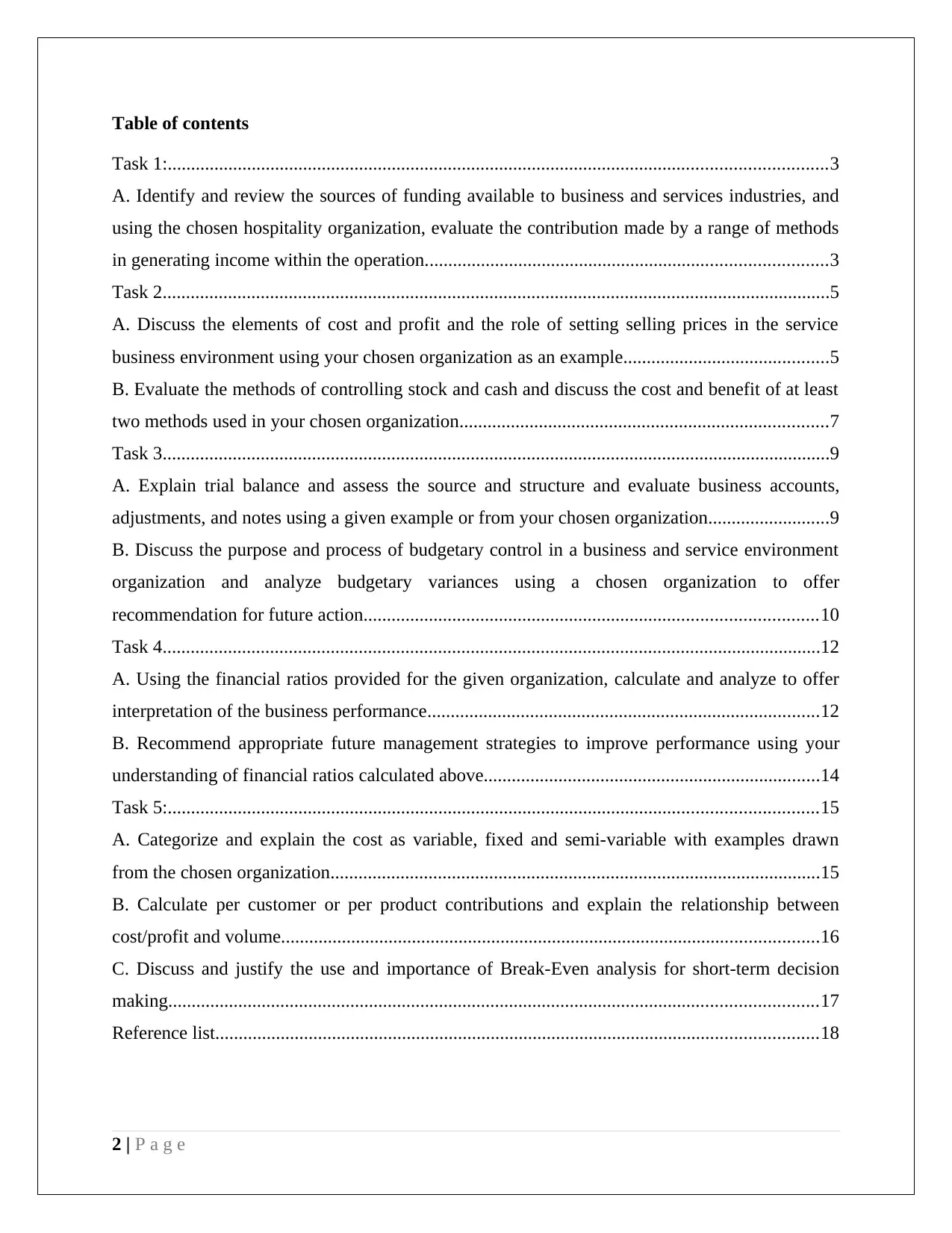
Table of contents
Task 1:.............................................................................................................................................3
A. Identify and review the sources of funding available to business and services industries, and
using the chosen hospitality organization, evaluate the contribution made by a range of methods
in generating income within the operation......................................................................................3
Task 2...............................................................................................................................................5
A. Discuss the elements of cost and profit and the role of setting selling prices in the service
business environment using your chosen organization as an example............................................5
B. Evaluate the methods of controlling stock and cash and discuss the cost and benefit of at least
two methods used in your chosen organization...............................................................................7
Task 3...............................................................................................................................................9
A. Explain trial balance and assess the source and structure and evaluate business accounts,
adjustments, and notes using a given example or from your chosen organization..........................9
B. Discuss the purpose and process of budgetary control in a business and service environment
organization and analyze budgetary variances using a chosen organization to offer
recommendation for future action.................................................................................................10
Task 4.............................................................................................................................................12
A. Using the financial ratios provided for the given organization, calculate and analyze to offer
interpretation of the business performance....................................................................................12
B. Recommend appropriate future management strategies to improve performance using your
understanding of financial ratios calculated above........................................................................14
Task 5:...........................................................................................................................................15
A. Categorize and explain the cost as variable, fixed and semi-variable with examples drawn
from the chosen organization.........................................................................................................15
B. Calculate per customer or per product contributions and explain the relationship between
cost/profit and volume...................................................................................................................16
C. Discuss and justify the use and importance of Break-Even analysis for short-term decision
making...........................................................................................................................................17
Reference list.................................................................................................................................18
2 | P a g e
Task 1:.............................................................................................................................................3
A. Identify and review the sources of funding available to business and services industries, and
using the chosen hospitality organization, evaluate the contribution made by a range of methods
in generating income within the operation......................................................................................3
Task 2...............................................................................................................................................5
A. Discuss the elements of cost and profit and the role of setting selling prices in the service
business environment using your chosen organization as an example............................................5
B. Evaluate the methods of controlling stock and cash and discuss the cost and benefit of at least
two methods used in your chosen organization...............................................................................7
Task 3...............................................................................................................................................9
A. Explain trial balance and assess the source and structure and evaluate business accounts,
adjustments, and notes using a given example or from your chosen organization..........................9
B. Discuss the purpose and process of budgetary control in a business and service environment
organization and analyze budgetary variances using a chosen organization to offer
recommendation for future action.................................................................................................10
Task 4.............................................................................................................................................12
A. Using the financial ratios provided for the given organization, calculate and analyze to offer
interpretation of the business performance....................................................................................12
B. Recommend appropriate future management strategies to improve performance using your
understanding of financial ratios calculated above........................................................................14
Task 5:...........................................................................................................................................15
A. Categorize and explain the cost as variable, fixed and semi-variable with examples drawn
from the chosen organization.........................................................................................................15
B. Calculate per customer or per product contributions and explain the relationship between
cost/profit and volume...................................................................................................................16
C. Discuss and justify the use and importance of Break-Even analysis for short-term decision
making...........................................................................................................................................17
Reference list.................................................................................................................................18
2 | P a g e
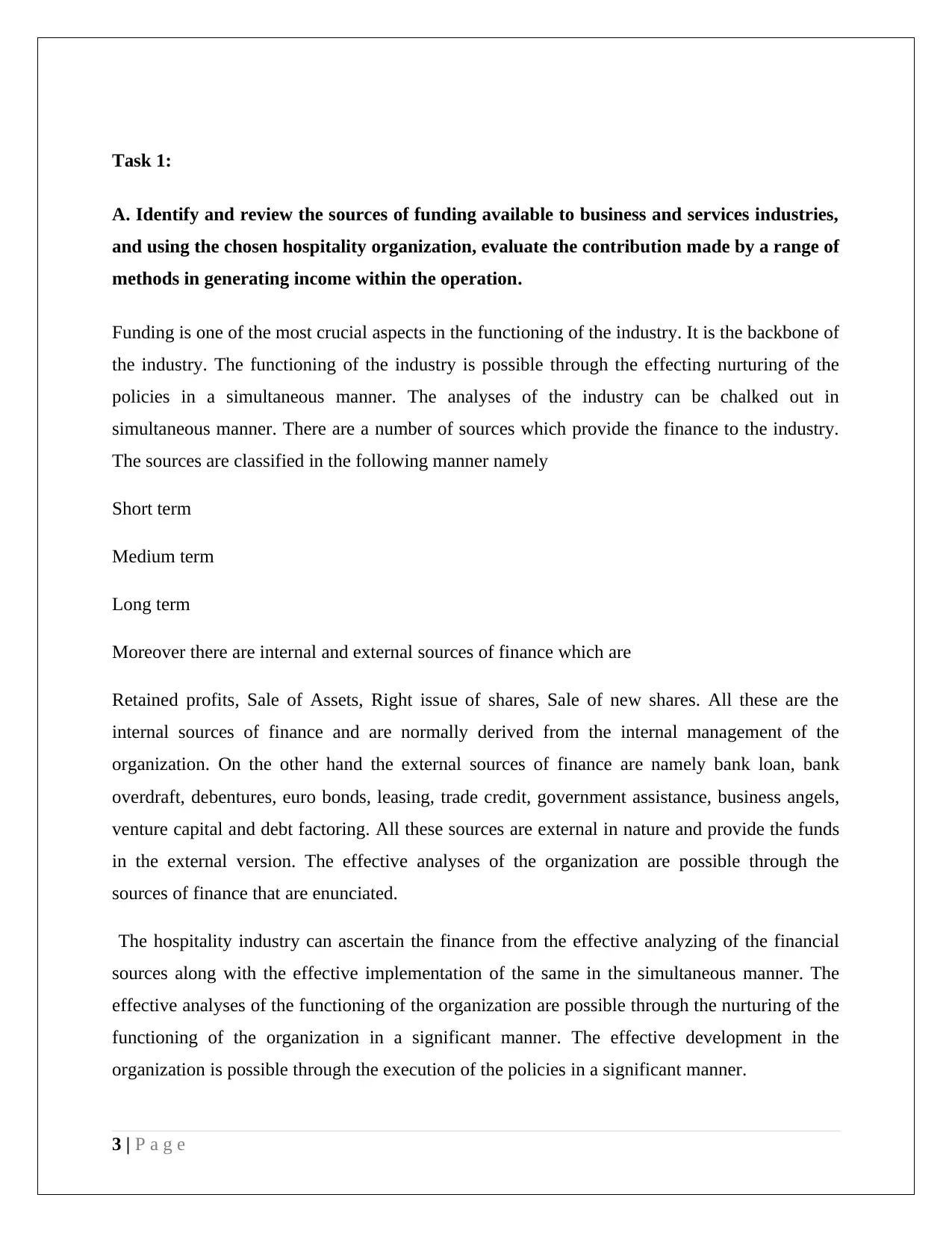
Task 1:
A. Identify and review the sources of funding available to business and services industries,
and using the chosen hospitality organization, evaluate the contribution made by a range of
methods in generating income within the operation.
Funding is one of the most crucial aspects in the functioning of the industry. It is the backbone of
the industry. The functioning of the industry is possible through the effecting nurturing of the
policies in a simultaneous manner. The analyses of the industry can be chalked out in
simultaneous manner. There are a number of sources which provide the finance to the industry.
The sources are classified in the following manner namely
Short term
Medium term
Long term
Moreover there are internal and external sources of finance which are
Retained profits, Sale of Assets, Right issue of shares, Sale of new shares. All these are the
internal sources of finance and are normally derived from the internal management of the
organization. On the other hand the external sources of finance are namely bank loan, bank
overdraft, debentures, euro bonds, leasing, trade credit, government assistance, business angels,
venture capital and debt factoring. All these sources are external in nature and provide the funds
in the external version. The effective analyses of the organization are possible through the
sources of finance that are enunciated.
The hospitality industry can ascertain the finance from the effective analyzing of the financial
sources along with the effective implementation of the same in the simultaneous manner. The
effective analyses of the functioning of the organization are possible through the nurturing of the
functioning of the organization in a significant manner. The effective development in the
organization is possible through the execution of the policies in a significant manner.
3 | P a g e
A. Identify and review the sources of funding available to business and services industries,
and using the chosen hospitality organization, evaluate the contribution made by a range of
methods in generating income within the operation.
Funding is one of the most crucial aspects in the functioning of the industry. It is the backbone of
the industry. The functioning of the industry is possible through the effecting nurturing of the
policies in a simultaneous manner. The analyses of the industry can be chalked out in
simultaneous manner. There are a number of sources which provide the finance to the industry.
The sources are classified in the following manner namely
Short term
Medium term
Long term
Moreover there are internal and external sources of finance which are
Retained profits, Sale of Assets, Right issue of shares, Sale of new shares. All these are the
internal sources of finance and are normally derived from the internal management of the
organization. On the other hand the external sources of finance are namely bank loan, bank
overdraft, debentures, euro bonds, leasing, trade credit, government assistance, business angels,
venture capital and debt factoring. All these sources are external in nature and provide the funds
in the external version. The effective analyses of the organization are possible through the
sources of finance that are enunciated.
The hospitality industry can ascertain the finance from the effective analyzing of the financial
sources along with the effective implementation of the same in the simultaneous manner. The
effective analyses of the functioning of the organization are possible through the nurturing of the
functioning of the organization in a significant manner. The effective development in the
organization is possible through the execution of the policies in a significant manner.
3 | P a g e
⊘ This is a preview!⊘
Do you want full access?
Subscribe today to unlock all pages.

Trusted by 1+ million students worldwide
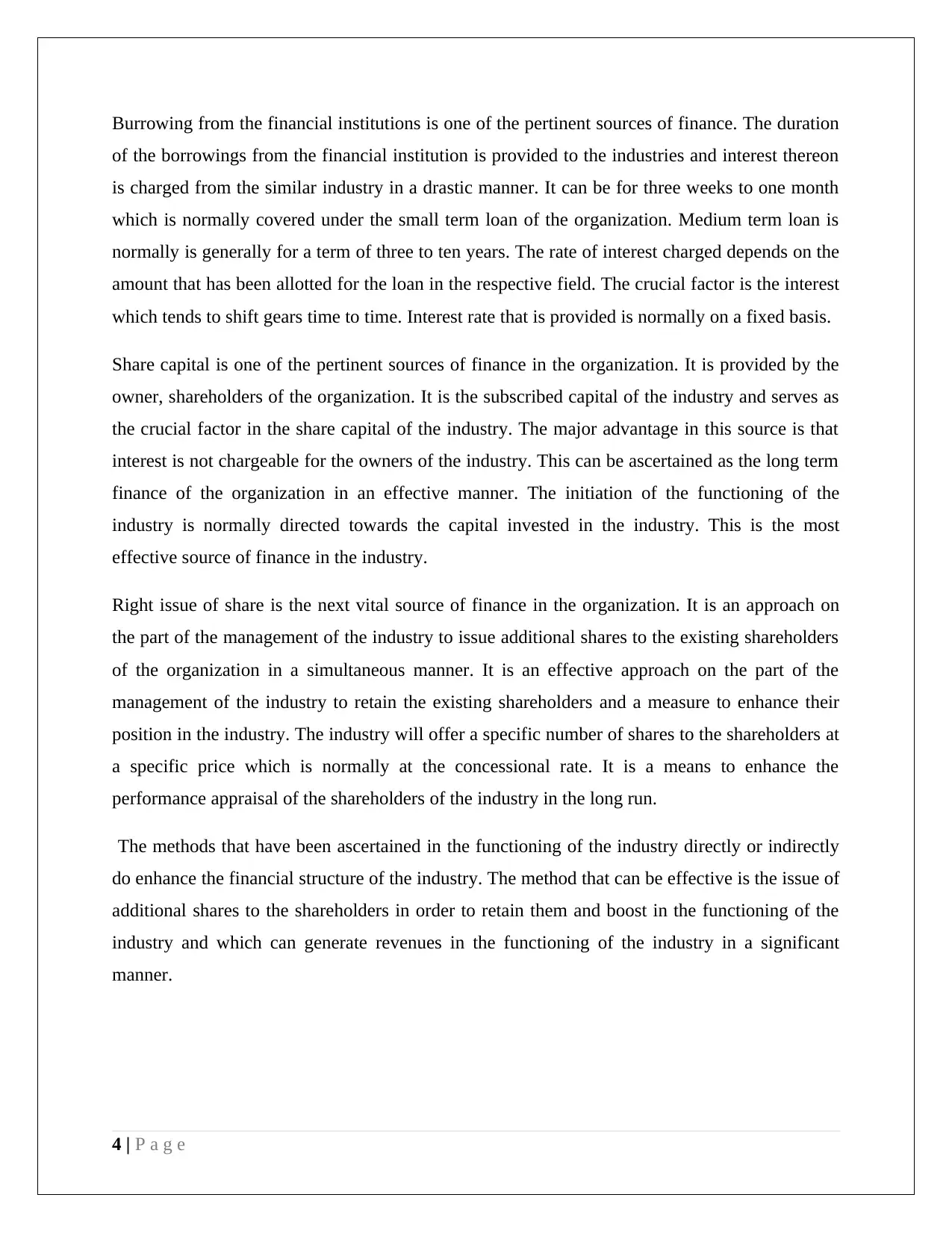
Burrowing from the financial institutions is one of the pertinent sources of finance. The duration
of the borrowings from the financial institution is provided to the industries and interest thereon
is charged from the similar industry in a drastic manner. It can be for three weeks to one month
which is normally covered under the small term loan of the organization. Medium term loan is
normally is generally for a term of three to ten years. The rate of interest charged depends on the
amount that has been allotted for the loan in the respective field. The crucial factor is the interest
which tends to shift gears time to time. Interest rate that is provided is normally on a fixed basis.
Share capital is one of the pertinent sources of finance in the organization. It is provided by the
owner, shareholders of the organization. It is the subscribed capital of the industry and serves as
the crucial factor in the share capital of the industry. The major advantage in this source is that
interest is not chargeable for the owners of the industry. This can be ascertained as the long term
finance of the organization in an effective manner. The initiation of the functioning of the
industry is normally directed towards the capital invested in the industry. This is the most
effective source of finance in the industry.
Right issue of share is the next vital source of finance in the organization. It is an approach on
the part of the management of the industry to issue additional shares to the existing shareholders
of the organization in a simultaneous manner. It is an effective approach on the part of the
management of the industry to retain the existing shareholders and a measure to enhance their
position in the industry. The industry will offer a specific number of shares to the shareholders at
a specific price which is normally at the concessional rate. It is a means to enhance the
performance appraisal of the shareholders of the industry in the long run.
The methods that have been ascertained in the functioning of the industry directly or indirectly
do enhance the financial structure of the industry. The method that can be effective is the issue of
additional shares to the shareholders in order to retain them and boost in the functioning of the
industry and which can generate revenues in the functioning of the industry in a significant
manner.
4 | P a g e
of the borrowings from the financial institution is provided to the industries and interest thereon
is charged from the similar industry in a drastic manner. It can be for three weeks to one month
which is normally covered under the small term loan of the organization. Medium term loan is
normally is generally for a term of three to ten years. The rate of interest charged depends on the
amount that has been allotted for the loan in the respective field. The crucial factor is the interest
which tends to shift gears time to time. Interest rate that is provided is normally on a fixed basis.
Share capital is one of the pertinent sources of finance in the organization. It is provided by the
owner, shareholders of the organization. It is the subscribed capital of the industry and serves as
the crucial factor in the share capital of the industry. The major advantage in this source is that
interest is not chargeable for the owners of the industry. This can be ascertained as the long term
finance of the organization in an effective manner. The initiation of the functioning of the
industry is normally directed towards the capital invested in the industry. This is the most
effective source of finance in the industry.
Right issue of share is the next vital source of finance in the organization. It is an approach on
the part of the management of the industry to issue additional shares to the existing shareholders
of the organization in a simultaneous manner. It is an effective approach on the part of the
management of the industry to retain the existing shareholders and a measure to enhance their
position in the industry. The industry will offer a specific number of shares to the shareholders at
a specific price which is normally at the concessional rate. It is a means to enhance the
performance appraisal of the shareholders of the industry in the long run.
The methods that have been ascertained in the functioning of the industry directly or indirectly
do enhance the financial structure of the industry. The method that can be effective is the issue of
additional shares to the shareholders in order to retain them and boost in the functioning of the
industry and which can generate revenues in the functioning of the industry in a significant
manner.
4 | P a g e
Paraphrase This Document
Need a fresh take? Get an instant paraphrase of this document with our AI Paraphraser
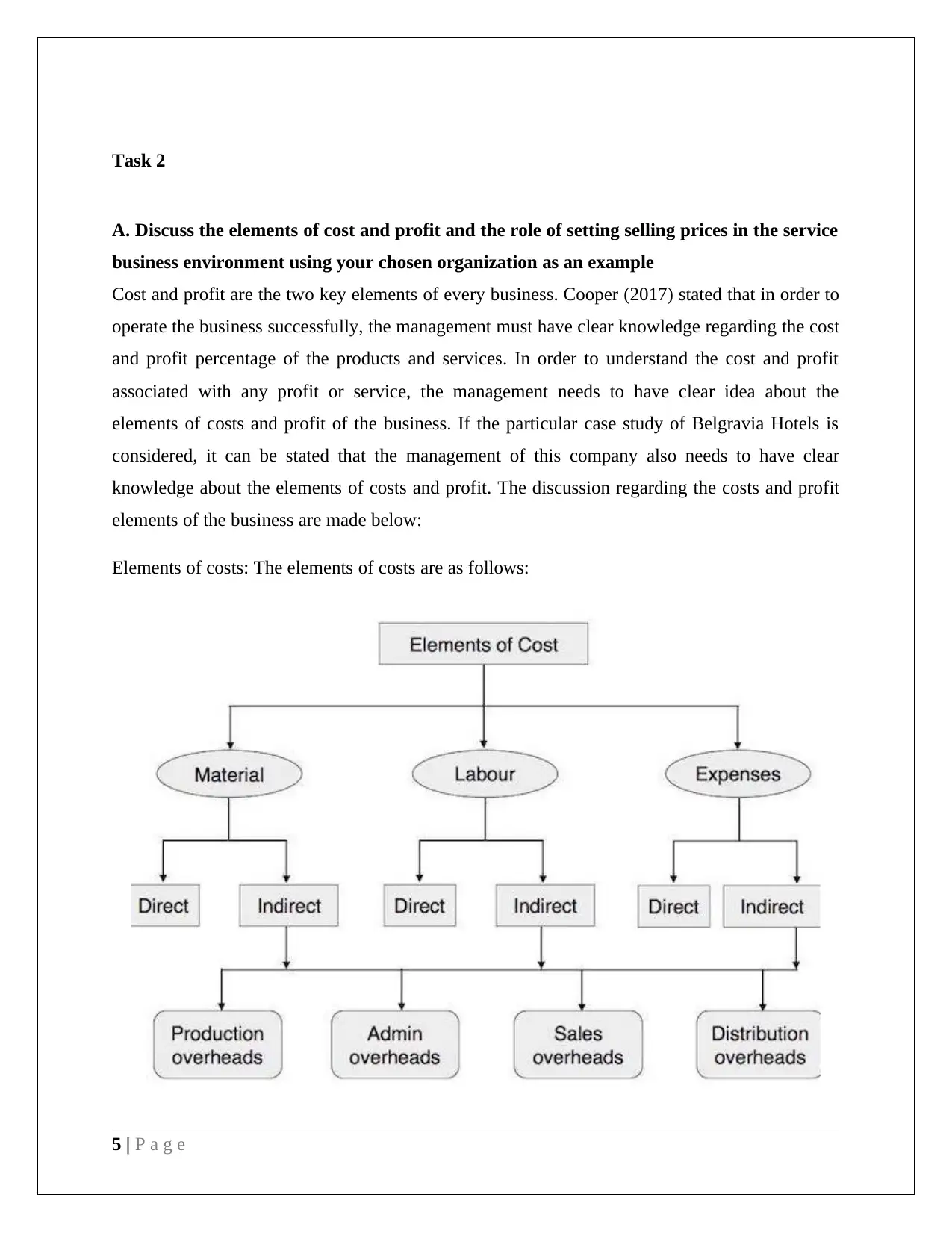
Task 2
A. Discuss the elements of cost and profit and the role of setting selling prices in the service
business environment using your chosen organization as an example
Cost and profit are the two key elements of every business. Cooper (2017) stated that in order to
operate the business successfully, the management must have clear knowledge regarding the cost
and profit percentage of the products and services. In order to understand the cost and profit
associated with any profit or service, the management needs to have clear idea about the
elements of costs and profit of the business. If the particular case study of Belgravia Hotels is
considered, it can be stated that the management of this company also needs to have clear
knowledge about the elements of costs and profit. The discussion regarding the costs and profit
elements of the business are made below:
Elements of costs: The elements of costs are as follows:
5 | P a g e
A. Discuss the elements of cost and profit and the role of setting selling prices in the service
business environment using your chosen organization as an example
Cost and profit are the two key elements of every business. Cooper (2017) stated that in order to
operate the business successfully, the management must have clear knowledge regarding the cost
and profit percentage of the products and services. In order to understand the cost and profit
associated with any profit or service, the management needs to have clear idea about the
elements of costs and profit of the business. If the particular case study of Belgravia Hotels is
considered, it can be stated that the management of this company also needs to have clear
knowledge about the elements of costs and profit. The discussion regarding the costs and profit
elements of the business are made below:
Elements of costs: The elements of costs are as follows:
5 | P a g e
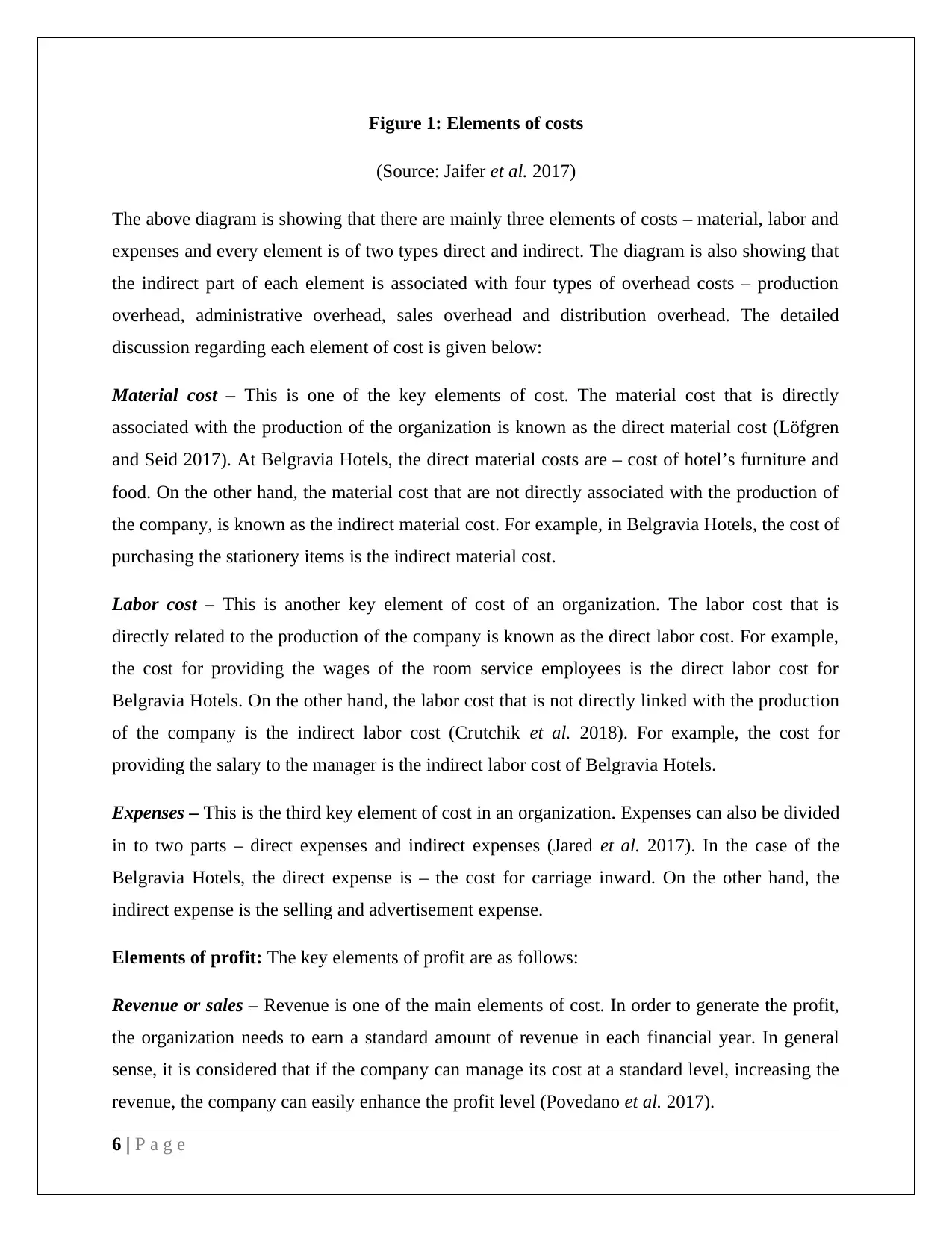
Figure 1: Elements of costs
(Source: Jaifer et al. 2017)
The above diagram is showing that there are mainly three elements of costs – material, labor and
expenses and every element is of two types direct and indirect. The diagram is also showing that
the indirect part of each element is associated with four types of overhead costs – production
overhead, administrative overhead, sales overhead and distribution overhead. The detailed
discussion regarding each element of cost is given below:
Material cost – This is one of the key elements of cost. The material cost that is directly
associated with the production of the organization is known as the direct material cost (Löfgren
and Seid 2017). At Belgravia Hotels, the direct material costs are – cost of hotel’s furniture and
food. On the other hand, the material cost that are not directly associated with the production of
the company, is known as the indirect material cost. For example, in Belgravia Hotels, the cost of
purchasing the stationery items is the indirect material cost.
Labor cost – This is another key element of cost of an organization. The labor cost that is
directly related to the production of the company is known as the direct labor cost. For example,
the cost for providing the wages of the room service employees is the direct labor cost for
Belgravia Hotels. On the other hand, the labor cost that is not directly linked with the production
of the company is the indirect labor cost (Crutchik et al. 2018). For example, the cost for
providing the salary to the manager is the indirect labor cost of Belgravia Hotels.
Expenses – This is the third key element of cost in an organization. Expenses can also be divided
in to two parts – direct expenses and indirect expenses (Jared et al. 2017). In the case of the
Belgravia Hotels, the direct expense is – the cost for carriage inward. On the other hand, the
indirect expense is the selling and advertisement expense.
Elements of profit: The key elements of profit are as follows:
Revenue or sales – Revenue is one of the main elements of cost. In order to generate the profit,
the organization needs to earn a standard amount of revenue in each financial year. In general
sense, it is considered that if the company can manage its cost at a standard level, increasing the
revenue, the company can easily enhance the profit level (Povedano et al. 2017).
6 | P a g e
(Source: Jaifer et al. 2017)
The above diagram is showing that there are mainly three elements of costs – material, labor and
expenses and every element is of two types direct and indirect. The diagram is also showing that
the indirect part of each element is associated with four types of overhead costs – production
overhead, administrative overhead, sales overhead and distribution overhead. The detailed
discussion regarding each element of cost is given below:
Material cost – This is one of the key elements of cost. The material cost that is directly
associated with the production of the organization is known as the direct material cost (Löfgren
and Seid 2017). At Belgravia Hotels, the direct material costs are – cost of hotel’s furniture and
food. On the other hand, the material cost that are not directly associated with the production of
the company, is known as the indirect material cost. For example, in Belgravia Hotels, the cost of
purchasing the stationery items is the indirect material cost.
Labor cost – This is another key element of cost of an organization. The labor cost that is
directly related to the production of the company is known as the direct labor cost. For example,
the cost for providing the wages of the room service employees is the direct labor cost for
Belgravia Hotels. On the other hand, the labor cost that is not directly linked with the production
of the company is the indirect labor cost (Crutchik et al. 2018). For example, the cost for
providing the salary to the manager is the indirect labor cost of Belgravia Hotels.
Expenses – This is the third key element of cost in an organization. Expenses can also be divided
in to two parts – direct expenses and indirect expenses (Jared et al. 2017). In the case of the
Belgravia Hotels, the direct expense is – the cost for carriage inward. On the other hand, the
indirect expense is the selling and advertisement expense.
Elements of profit: The key elements of profit are as follows:
Revenue or sales – Revenue is one of the main elements of cost. In order to generate the profit,
the organization needs to earn a standard amount of revenue in each financial year. In general
sense, it is considered that if the company can manage its cost at a standard level, increasing the
revenue, the company can easily enhance the profit level (Povedano et al. 2017).
6 | P a g e
⊘ This is a preview!⊘
Do you want full access?
Subscribe today to unlock all pages.

Trusted by 1+ million students worldwide
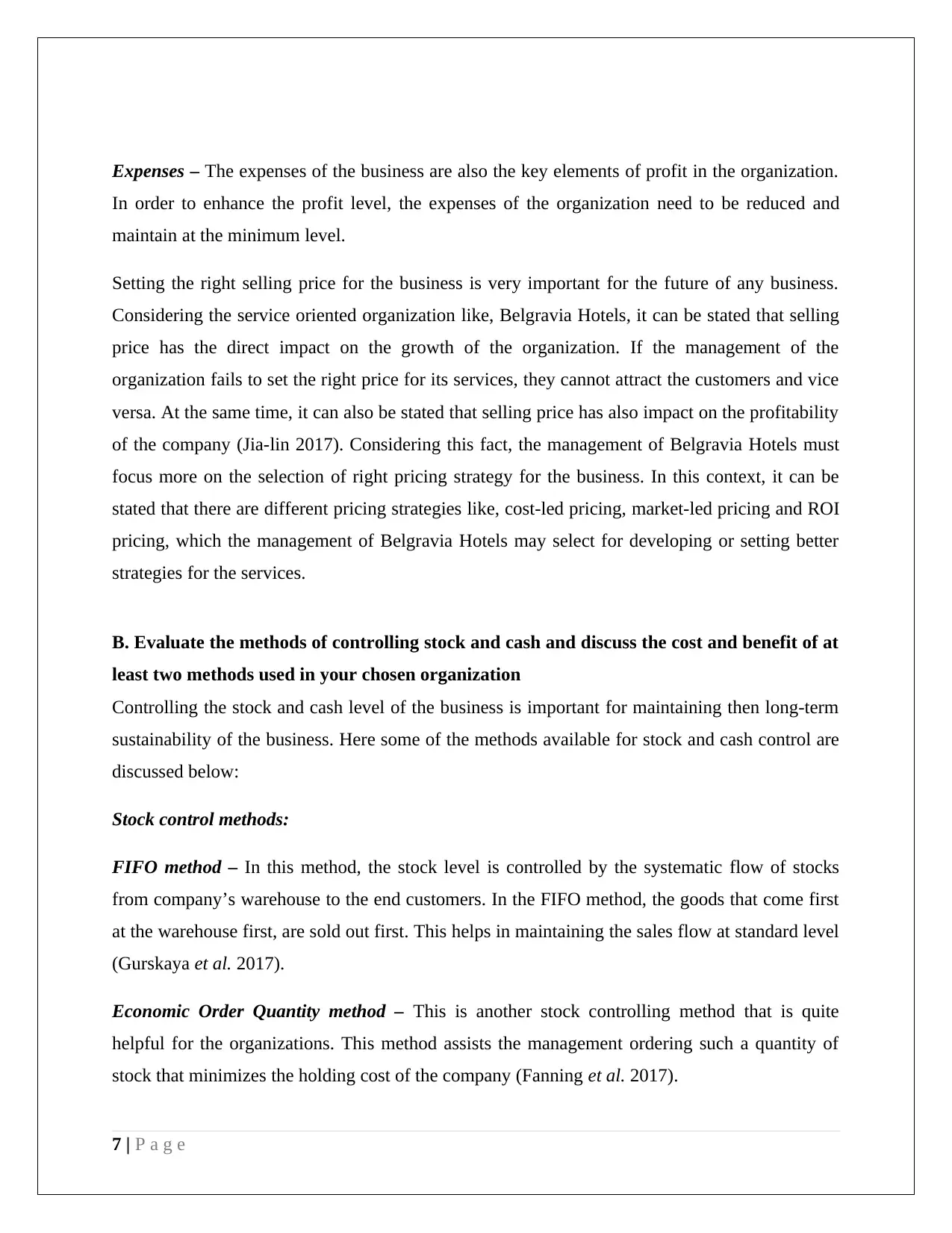
Expenses – The expenses of the business are also the key elements of profit in the organization.
In order to enhance the profit level, the expenses of the organization need to be reduced and
maintain at the minimum level.
Setting the right selling price for the business is very important for the future of any business.
Considering the service oriented organization like, Belgravia Hotels, it can be stated that selling
price has the direct impact on the growth of the organization. If the management of the
organization fails to set the right price for its services, they cannot attract the customers and vice
versa. At the same time, it can also be stated that selling price has also impact on the profitability
of the company (Jia-lin 2017). Considering this fact, the management of Belgravia Hotels must
focus more on the selection of right pricing strategy for the business. In this context, it can be
stated that there are different pricing strategies like, cost-led pricing, market-led pricing and ROI
pricing, which the management of Belgravia Hotels may select for developing or setting better
strategies for the services.
B. Evaluate the methods of controlling stock and cash and discuss the cost and benefit of at
least two methods used in your chosen organization
Controlling the stock and cash level of the business is important for maintaining then long-term
sustainability of the business. Here some of the methods available for stock and cash control are
discussed below:
Stock control methods:
FIFO method – In this method, the stock level is controlled by the systematic flow of stocks
from company’s warehouse to the end customers. In the FIFO method, the goods that come first
at the warehouse first, are sold out first. This helps in maintaining the sales flow at standard level
(Gurskaya et al. 2017).
Economic Order Quantity method – This is another stock controlling method that is quite
helpful for the organizations. This method assists the management ordering such a quantity of
stock that minimizes the holding cost of the company (Fanning et al. 2017).
7 | P a g e
In order to enhance the profit level, the expenses of the organization need to be reduced and
maintain at the minimum level.
Setting the right selling price for the business is very important for the future of any business.
Considering the service oriented organization like, Belgravia Hotels, it can be stated that selling
price has the direct impact on the growth of the organization. If the management of the
organization fails to set the right price for its services, they cannot attract the customers and vice
versa. At the same time, it can also be stated that selling price has also impact on the profitability
of the company (Jia-lin 2017). Considering this fact, the management of Belgravia Hotels must
focus more on the selection of right pricing strategy for the business. In this context, it can be
stated that there are different pricing strategies like, cost-led pricing, market-led pricing and ROI
pricing, which the management of Belgravia Hotels may select for developing or setting better
strategies for the services.
B. Evaluate the methods of controlling stock and cash and discuss the cost and benefit of at
least two methods used in your chosen organization
Controlling the stock and cash level of the business is important for maintaining then long-term
sustainability of the business. Here some of the methods available for stock and cash control are
discussed below:
Stock control methods:
FIFO method – In this method, the stock level is controlled by the systematic flow of stocks
from company’s warehouse to the end customers. In the FIFO method, the goods that come first
at the warehouse first, are sold out first. This helps in maintaining the sales flow at standard level
(Gurskaya et al. 2017).
Economic Order Quantity method – This is another stock controlling method that is quite
helpful for the organizations. This method assists the management ordering such a quantity of
stock that minimizes the holding cost of the company (Fanning et al. 2017).
7 | P a g e
Paraphrase This Document
Need a fresh take? Get an instant paraphrase of this document with our AI Paraphraser
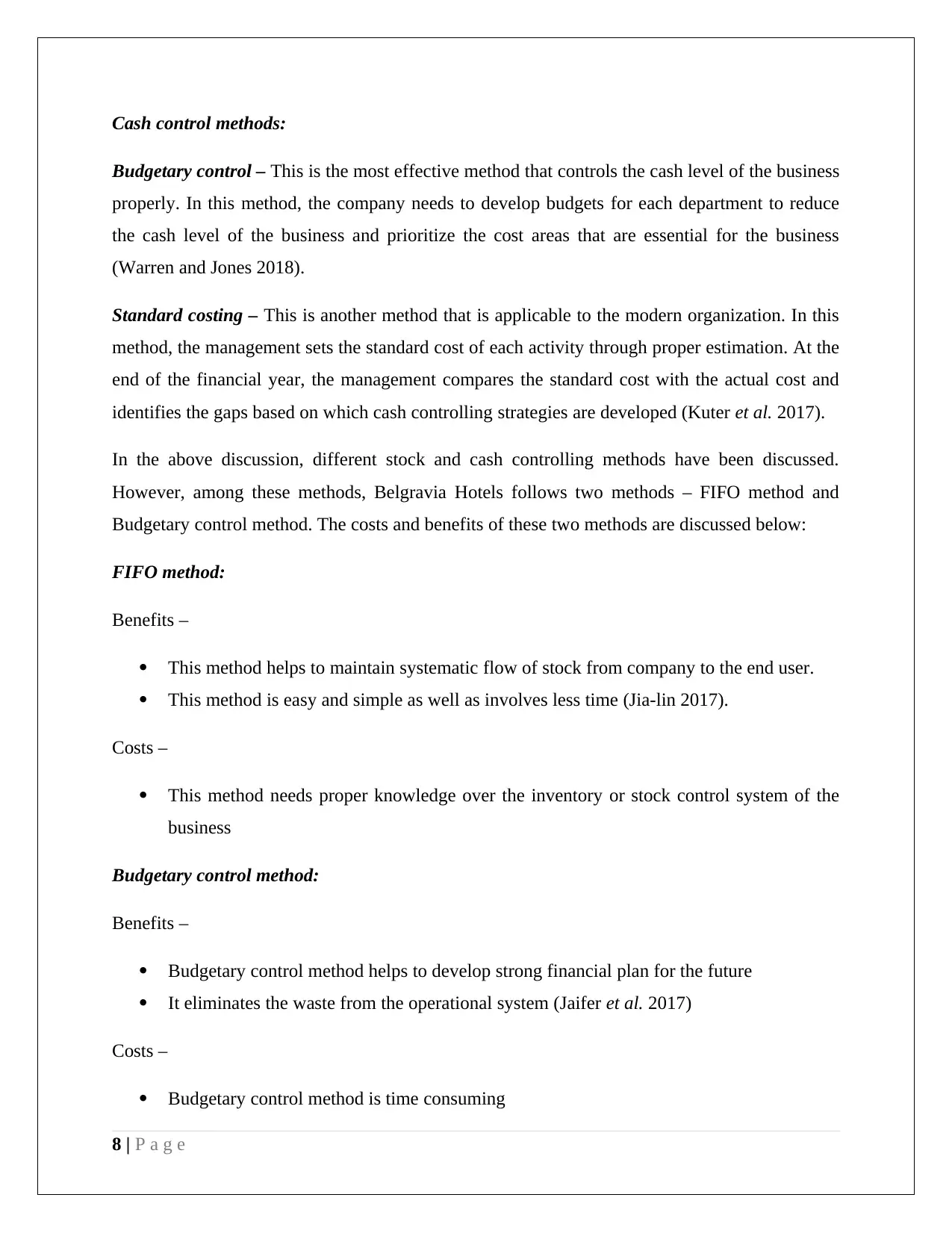
Cash control methods:
Budgetary control – This is the most effective method that controls the cash level of the business
properly. In this method, the company needs to develop budgets for each department to reduce
the cash level of the business and prioritize the cost areas that are essential for the business
(Warren and Jones 2018).
Standard costing – This is another method that is applicable to the modern organization. In this
method, the management sets the standard cost of each activity through proper estimation. At the
end of the financial year, the management compares the standard cost with the actual cost and
identifies the gaps based on which cash controlling strategies are developed (Kuter et al. 2017).
In the above discussion, different stock and cash controlling methods have been discussed.
However, among these methods, Belgravia Hotels follows two methods – FIFO method and
Budgetary control method. The costs and benefits of these two methods are discussed below:
FIFO method:
Benefits –
This method helps to maintain systematic flow of stock from company to the end user.
This method is easy and simple as well as involves less time (Jia-lin 2017).
Costs –
This method needs proper knowledge over the inventory or stock control system of the
business
Budgetary control method:
Benefits –
Budgetary control method helps to develop strong financial plan for the future
It eliminates the waste from the operational system (Jaifer et al. 2017)
Costs –
Budgetary control method is time consuming
8 | P a g e
Budgetary control – This is the most effective method that controls the cash level of the business
properly. In this method, the company needs to develop budgets for each department to reduce
the cash level of the business and prioritize the cost areas that are essential for the business
(Warren and Jones 2018).
Standard costing – This is another method that is applicable to the modern organization. In this
method, the management sets the standard cost of each activity through proper estimation. At the
end of the financial year, the management compares the standard cost with the actual cost and
identifies the gaps based on which cash controlling strategies are developed (Kuter et al. 2017).
In the above discussion, different stock and cash controlling methods have been discussed.
However, among these methods, Belgravia Hotels follows two methods – FIFO method and
Budgetary control method. The costs and benefits of these two methods are discussed below:
FIFO method:
Benefits –
This method helps to maintain systematic flow of stock from company to the end user.
This method is easy and simple as well as involves less time (Jia-lin 2017).
Costs –
This method needs proper knowledge over the inventory or stock control system of the
business
Budgetary control method:
Benefits –
Budgetary control method helps to develop strong financial plan for the future
It eliminates the waste from the operational system (Jaifer et al. 2017)
Costs –
Budgetary control method is time consuming
8 | P a g e
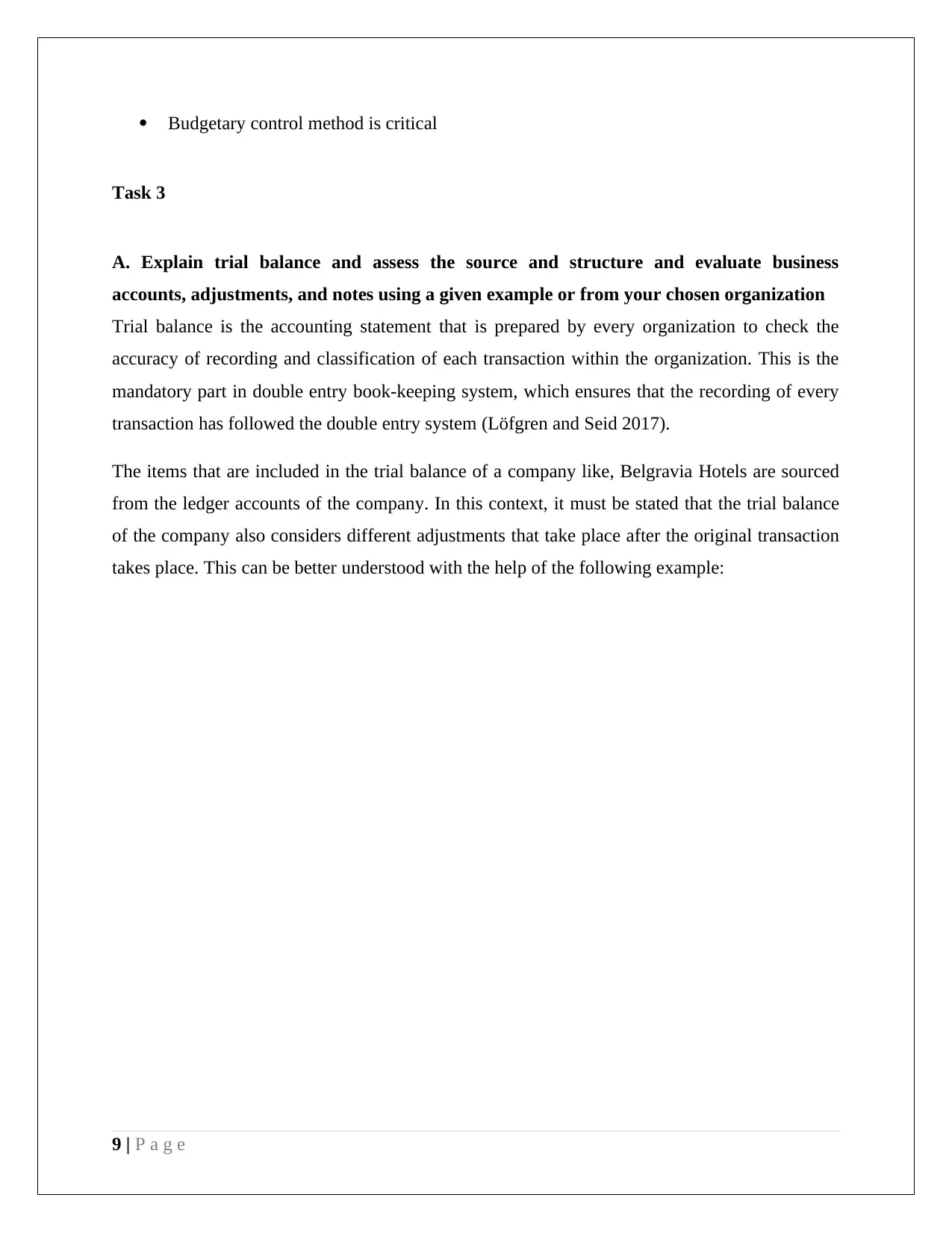
Budgetary control method is critical
Task 3
A. Explain trial balance and assess the source and structure and evaluate business
accounts, adjustments, and notes using a given example or from your chosen organization
Trial balance is the accounting statement that is prepared by every organization to check the
accuracy of recording and classification of each transaction within the organization. This is the
mandatory part in double entry book-keeping system, which ensures that the recording of every
transaction has followed the double entry system (Löfgren and Seid 2017).
The items that are included in the trial balance of a company like, Belgravia Hotels are sourced
from the ledger accounts of the company. In this context, it must be stated that the trial balance
of the company also considers different adjustments that take place after the original transaction
takes place. This can be better understood with the help of the following example:
9 | P a g e
Task 3
A. Explain trial balance and assess the source and structure and evaluate business
accounts, adjustments, and notes using a given example or from your chosen organization
Trial balance is the accounting statement that is prepared by every organization to check the
accuracy of recording and classification of each transaction within the organization. This is the
mandatory part in double entry book-keeping system, which ensures that the recording of every
transaction has followed the double entry system (Löfgren and Seid 2017).
The items that are included in the trial balance of a company like, Belgravia Hotels are sourced
from the ledger accounts of the company. In this context, it must be stated that the trial balance
of the company also considers different adjustments that take place after the original transaction
takes place. This can be better understood with the help of the following example:
9 | P a g e
⊘ This is a preview!⊘
Do you want full access?
Subscribe today to unlock all pages.

Trusted by 1+ million students worldwide
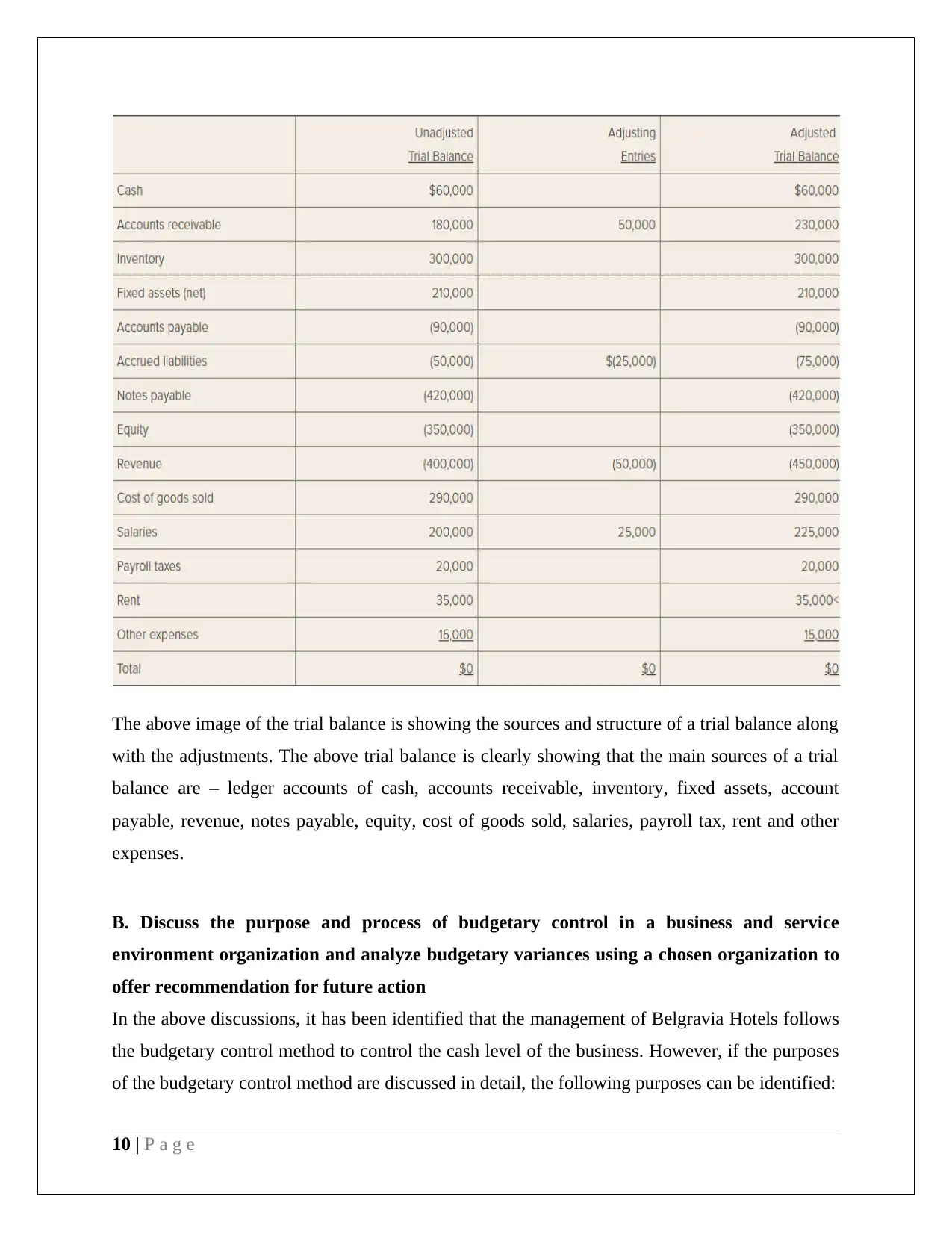
The above image of the trial balance is showing the sources and structure of a trial balance along
with the adjustments. The above trial balance is clearly showing that the main sources of a trial
balance are – ledger accounts of cash, accounts receivable, inventory, fixed assets, account
payable, revenue, notes payable, equity, cost of goods sold, salaries, payroll tax, rent and other
expenses.
B. Discuss the purpose and process of budgetary control in a business and service
environment organization and analyze budgetary variances using a chosen organization to
offer recommendation for future action
In the above discussions, it has been identified that the management of Belgravia Hotels follows
the budgetary control method to control the cash level of the business. However, if the purposes
of the budgetary control method are discussed in detail, the following purposes can be identified:
10 | P a g e
with the adjustments. The above trial balance is clearly showing that the main sources of a trial
balance are – ledger accounts of cash, accounts receivable, inventory, fixed assets, account
payable, revenue, notes payable, equity, cost of goods sold, salaries, payroll tax, rent and other
expenses.
B. Discuss the purpose and process of budgetary control in a business and service
environment organization and analyze budgetary variances using a chosen organization to
offer recommendation for future action
In the above discussions, it has been identified that the management of Belgravia Hotels follows
the budgetary control method to control the cash level of the business. However, if the purposes
of the budgetary control method are discussed in detail, the following purposes can be identified:
10 | P a g e
Paraphrase This Document
Need a fresh take? Get an instant paraphrase of this document with our AI Paraphraser
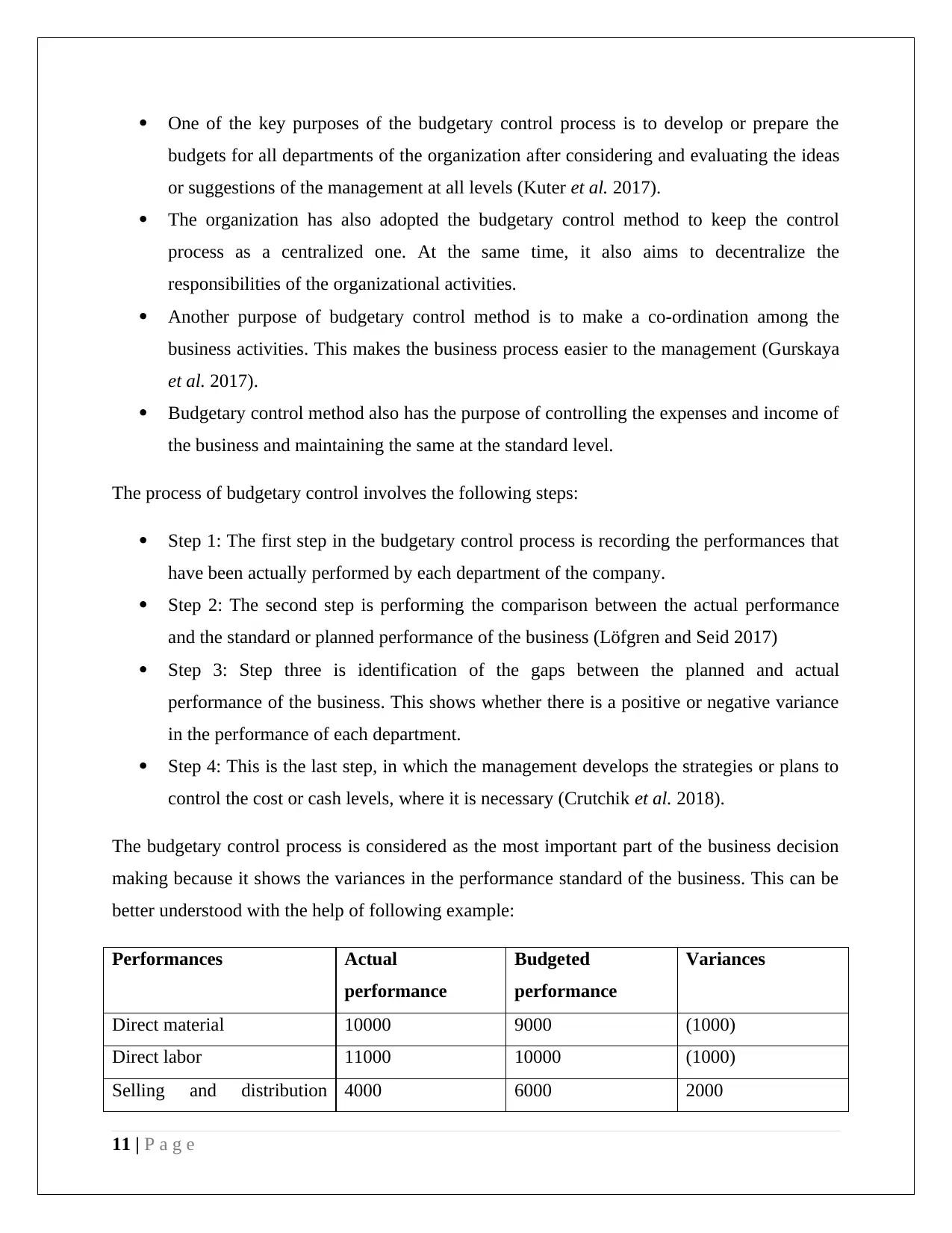
One of the key purposes of the budgetary control process is to develop or prepare the
budgets for all departments of the organization after considering and evaluating the ideas
or suggestions of the management at all levels (Kuter et al. 2017).
The organization has also adopted the budgetary control method to keep the control
process as a centralized one. At the same time, it also aims to decentralize the
responsibilities of the organizational activities.
Another purpose of budgetary control method is to make a co-ordination among the
business activities. This makes the business process easier to the management (Gurskaya
et al. 2017).
Budgetary control method also has the purpose of controlling the expenses and income of
the business and maintaining the same at the standard level.
The process of budgetary control involves the following steps:
Step 1: The first step in the budgetary control process is recording the performances that
have been actually performed by each department of the company.
Step 2: The second step is performing the comparison between the actual performance
and the standard or planned performance of the business (Löfgren and Seid 2017)
Step 3: Step three is identification of the gaps between the planned and actual
performance of the business. This shows whether there is a positive or negative variance
in the performance of each department.
Step 4: This is the last step, in which the management develops the strategies or plans to
control the cost or cash levels, where it is necessary (Crutchik et al. 2018).
The budgetary control process is considered as the most important part of the business decision
making because it shows the variances in the performance standard of the business. This can be
better understood with the help of following example:
Performances Actual
performance
Budgeted
performance
Variances
Direct material 10000 9000 (1000)
Direct labor 11000 10000 (1000)
Selling and distribution 4000 6000 2000
11 | P a g e
budgets for all departments of the organization after considering and evaluating the ideas
or suggestions of the management at all levels (Kuter et al. 2017).
The organization has also adopted the budgetary control method to keep the control
process as a centralized one. At the same time, it also aims to decentralize the
responsibilities of the organizational activities.
Another purpose of budgetary control method is to make a co-ordination among the
business activities. This makes the business process easier to the management (Gurskaya
et al. 2017).
Budgetary control method also has the purpose of controlling the expenses and income of
the business and maintaining the same at the standard level.
The process of budgetary control involves the following steps:
Step 1: The first step in the budgetary control process is recording the performances that
have been actually performed by each department of the company.
Step 2: The second step is performing the comparison between the actual performance
and the standard or planned performance of the business (Löfgren and Seid 2017)
Step 3: Step three is identification of the gaps between the planned and actual
performance of the business. This shows whether there is a positive or negative variance
in the performance of each department.
Step 4: This is the last step, in which the management develops the strategies or plans to
control the cost or cash levels, where it is necessary (Crutchik et al. 2018).
The budgetary control process is considered as the most important part of the business decision
making because it shows the variances in the performance standard of the business. This can be
better understood with the help of following example:
Performances Actual
performance
Budgeted
performance
Variances
Direct material 10000 9000 (1000)
Direct labor 11000 10000 (1000)
Selling and distribution 4000 6000 2000
11 | P a g e
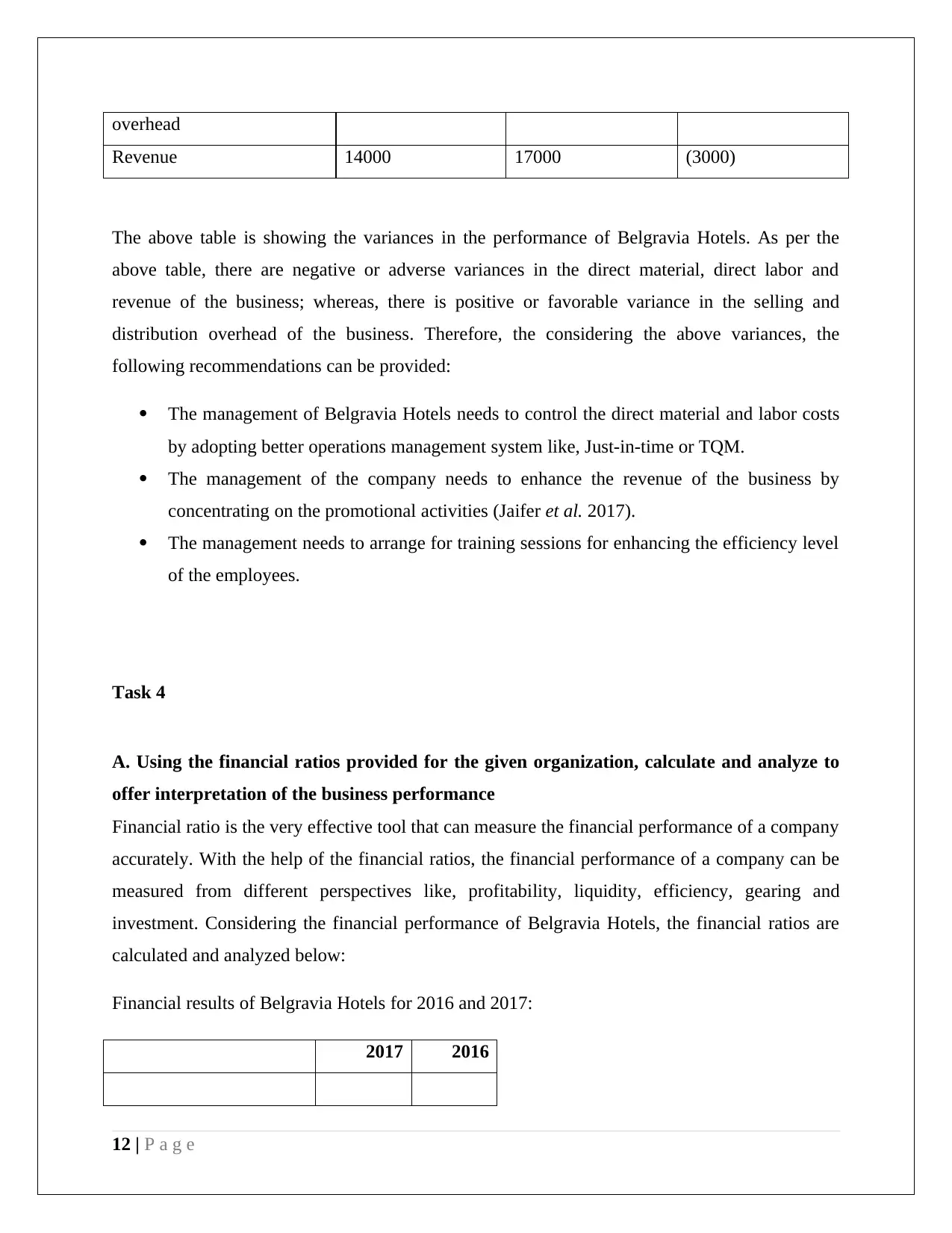
overhead
Revenue 14000 17000 (3000)
The above table is showing the variances in the performance of Belgravia Hotels. As per the
above table, there are negative or adverse variances in the direct material, direct labor and
revenue of the business; whereas, there is positive or favorable variance in the selling and
distribution overhead of the business. Therefore, the considering the above variances, the
following recommendations can be provided:
The management of Belgravia Hotels needs to control the direct material and labor costs
by adopting better operations management system like, Just-in-time or TQM.
The management of the company needs to enhance the revenue of the business by
concentrating on the promotional activities (Jaifer et al. 2017).
The management needs to arrange for training sessions for enhancing the efficiency level
of the employees.
Task 4
A. Using the financial ratios provided for the given organization, calculate and analyze to
offer interpretation of the business performance
Financial ratio is the very effective tool that can measure the financial performance of a company
accurately. With the help of the financial ratios, the financial performance of a company can be
measured from different perspectives like, profitability, liquidity, efficiency, gearing and
investment. Considering the financial performance of Belgravia Hotels, the financial ratios are
calculated and analyzed below:
Financial results of Belgravia Hotels for 2016 and 2017:
2017 2016
12 | P a g e
Revenue 14000 17000 (3000)
The above table is showing the variances in the performance of Belgravia Hotels. As per the
above table, there are negative or adverse variances in the direct material, direct labor and
revenue of the business; whereas, there is positive or favorable variance in the selling and
distribution overhead of the business. Therefore, the considering the above variances, the
following recommendations can be provided:
The management of Belgravia Hotels needs to control the direct material and labor costs
by adopting better operations management system like, Just-in-time or TQM.
The management of the company needs to enhance the revenue of the business by
concentrating on the promotional activities (Jaifer et al. 2017).
The management needs to arrange for training sessions for enhancing the efficiency level
of the employees.
Task 4
A. Using the financial ratios provided for the given organization, calculate and analyze to
offer interpretation of the business performance
Financial ratio is the very effective tool that can measure the financial performance of a company
accurately. With the help of the financial ratios, the financial performance of a company can be
measured from different perspectives like, profitability, liquidity, efficiency, gearing and
investment. Considering the financial performance of Belgravia Hotels, the financial ratios are
calculated and analyzed below:
Financial results of Belgravia Hotels for 2016 and 2017:
2017 2016
12 | P a g e
⊘ This is a preview!⊘
Do you want full access?
Subscribe today to unlock all pages.

Trusted by 1+ million students worldwide
1 out of 20
Related Documents
Your All-in-One AI-Powered Toolkit for Academic Success.
+13062052269
info@desklib.com
Available 24*7 on WhatsApp / Email
![[object Object]](/_next/static/media/star-bottom.7253800d.svg)
Unlock your academic potential
Copyright © 2020–2025 A2Z Services. All Rights Reserved. Developed and managed by ZUCOL.





